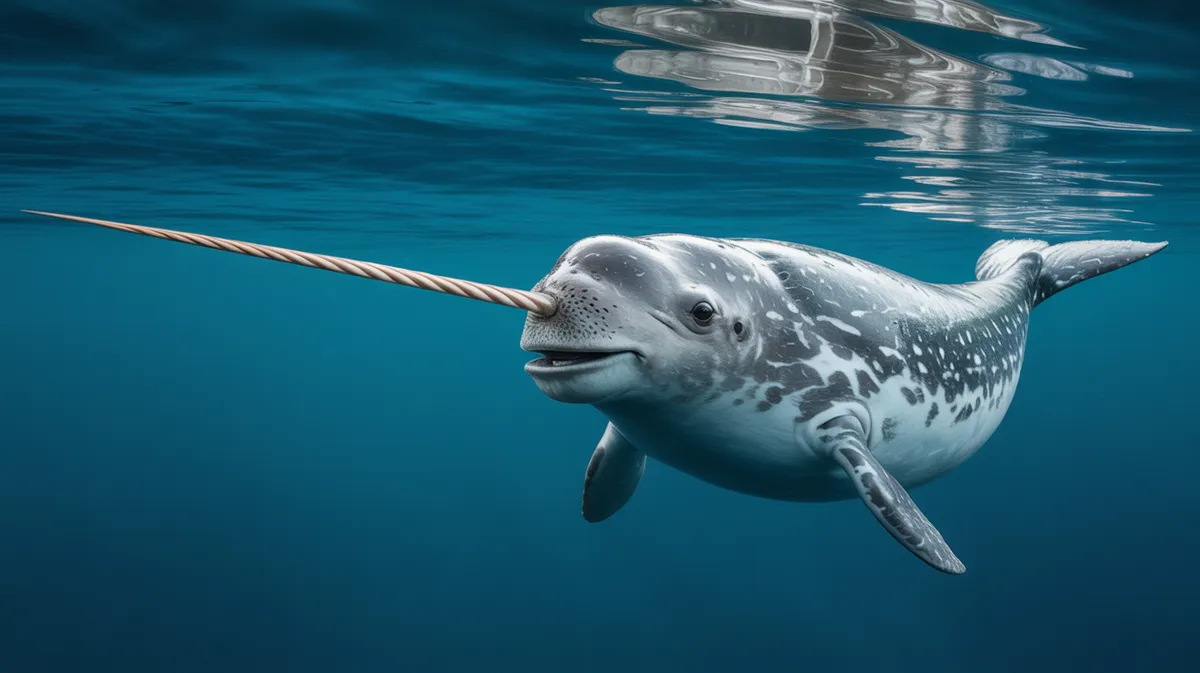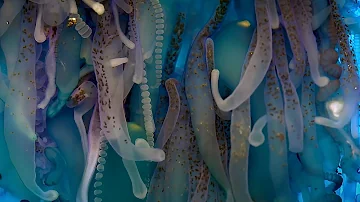
Narwhal
Monodon monoceros

Meet the Narwhal
The narwhal is a medium-sized toothed whale best known for the long, spiral tusk that projects from the head of males and some females. Native to the Arctic waters around Greenland, Canada, and Russia, narwhals are highly adapted to life in cold, icy environments. They are deep divers, capable of reaching depths of up to 1,500 meters in search of fish, squid, and shrimp. Narwhals live in pods and are well known for their elusive nature, making them difficult to study in the wild.
Classification
Mammal
Habitat
Arctic Ocean
Diet
Carnivore
Lifespan
30-50 years
Conservation
Near Threatened
Weight
800–1,600 kg
📖Fascinating Facts
Unicorn of the Sea
The narwhal's tusk is a spiraled tooth that can reach up to 3 meters (about 10 feet) in length and contains up to 10 million nerve endings.
Arctic Specialist
Narwhals are uniquely adapted to life in Arctic waters and spend their entire lives in and around the sea ice, rarely venturing far south.
Deep Divers
Narwhals can dive as deep as 1,500 meters (4,900 feet) and may perform hundreds of deep dives per day while hunting for food.
📋Detailed Description
The narwhal (Monodon monoceros) is a medium-sized odontocete (toothed whale) distinguished by its robust, mottled gray body, absence of a dorsal fin, and a prominent, helical tusk extending from the upper left jaw in most males and occasionally in females. Adults typically measure 3.8–5.5 meters in length, with males often slightly larger than females, and weigh between 800 and 1,600 kilograms. The tusk, which can reach up to 3 meters, is a highly innervated, sensory organ containing millions of nerve endings, capable of detecting changes in water temperature, pressure, and salinity. Narwhals possess a thick layer of blubber, up to 10 centimeters, which insulates them against the frigid Arctic waters. Their neck vertebrae are not fused, unlike most cetaceans, granting them greater head mobility. Socially, narwhals form pods ranging from a few individuals to groups exceeding 100 during summer aggregations. They are deep-diving specialists, regularly descending to depths of 800–1,500 meters and occasionally reaching over 1,800 meters, with dives lasting up to 25 minutes. Narwhals communicate using a complex array of clicks, whistles, and knocks, facilitating echolocation and social interactions. Their elusive nature and preference for dense pack ice make them one of the least studied cetaceans, yet they play a crucial ecological role as both predator and prey in Arctic marine ecosystems.
💡 Did you know?
Despite their intimidating tusks, narwhals have no functional teeth in their mouths and swallow prey whole.
🔬Research & Sources
Wikipedia Summary
The narwhal is a species of toothed whale native to the Arctic. It is the only member of the genus Monodon and one of two living representatives of the family Monodontidae. The narwhal is a stocky cetacean with a relatively blunt snout, a large melon, and a shallow ridge in place of a dorsal fin. Males of this species have a large long tusk, which is a protruding left canine thought to function as a weapon, a tool for feeding, in attracting mates or sensing water salinity. Specially adapted slow-twitch muscles, along with the jointed neck vertebrae and shallow dorsal ridge allow for easy movement through the Arctic environment, where the narwhal spends extended periods at great depths. The narwhal's geographic range overlaps with that of the similarly built and closely related beluga whale, and the animals are known to interbreed.
Last Modified: 5/22/2025
🎭Behavior & Social Structure
Narwhals exhibit highly social behavior, typically traveling in pods composed of related females and juveniles, while adult males may form separate bachelor groups or join mixed pods during the summer. They are known for their seasonal migrations, moving from shallow coastal bays in summer to deeper offshore waters in winter, often beneath dense sea ice. Narwhals feed primarily on Greenland halibut, Arctic and polar cod, squid, and shrimp, employing suction feeding to capture prey at great depths. Foraging occurs predominantly during deep dives, with individuals making hundreds of dives per day. Social interactions include synchronized swimming, vocalizations, and, among males, 'tusking'—rubbing tusks together, which may serve as a display of dominance or social bonding. Rest periods are interspersed with active foraging, and narwhals are known to navigate complex ice environments using echolocation.
👶Reproduction & Life Cycle
Narwhals reach sexual maturity between 6 and 9 years of age. Mating occurs in late spring (April–May), often beneath the sea ice. After a gestation period of approximately 14–15 months, females give birth to a single calf, usually between June and August of the following year. Calves are born measuring about 1.5 meters in length and weighing around 80 kilograms. Maternal care is pronounced, with calves nursing for up to 20 months, though they begin to consume solid food within their first year. Calving intervals are typically three years, reflecting the long gestation and extended maternal investment. There is little evidence of paternal care, and breeding success is closely tied to environmental conditions and prey availability.
🛡️Adaptations & Survival
Narwhals are uniquely adapted to the extreme Arctic environment. Their thick blubber provides insulation and energy reserves during periods of food scarcity. The absence of a dorsal fin reduces heat loss and facilitates movement beneath ice. Their flexible neck vertebrae allow for increased maneuverability when navigating under ice floes. Specialized slow-twitch muscle fibers enable prolonged deep dives and efficient oxygen utilization. The tusk, once thought to be solely a weapon, is now recognized as a sensitive organ for environmental sensing. Narwhals possess highly developed echolocation abilities, essential for hunting in the dark, turbid waters beneath ice. Seasonal migrations and the ability to fast for extended periods further enhance their survival in a variable and often harsh environment.
🎨Cultural Significance
Narwhals hold a prominent place in the cultures and mythologies of Arctic Indigenous peoples, such as the Inuit, who have traditionally hunted them for their meat, blubber, and tusks. The tusk, often referred to as a 'unicorn horn,' was historically traded to Europe, where it was believed to possess magical or medicinal properties. Narwhals feature in Inuit legends as mystical creatures and are symbols of endurance and adaptation. In contemporary times, the narwhal has become an emblem of Arctic conservation and climate change awareness, frequently depicted in art, literature, and popular media.
🔬Recent Research & Discoveries
Recent research has focused on the sensory function of the narwhal tusk, revealing its role as a sophisticated environmental sensor. Satellite tagging studies have provided new insights into narwhal migration, dive behavior, and responses to sea ice loss. Genetic analyses have confirmed occasional hybridization with beluga whales (Delphinapterus leucas), producing viable offspring. Long-term monitoring projects are assessing the impacts of climate change on narwhal distribution, health, and prey dynamics. Acoustic studies are expanding our understanding of narwhal communication and the potential impacts of anthropogenic noise.
🎥Wildlife Videos

Narwhals: The Unicorns of the Sea! | Nat Geo WILD
About National Geographic Wild: National Geographic Wild is a place for all things animals and for animal-lovers alike. Take a ...
Nat Geo Animals

Narwhals | World's Weirdest
#NatGeoWILD #WorldsWeirdest #Narwhals About World's Weirdest: A buffalo with three eyes, an exterminator who eats his day's ...
Nat Geo Animals

Our Planet | Narwhals | Clip | Netflix
Share the wonder of the extraordinary place we call home. Utilizing the latest technology Our Planet was filmed entirely in Ultra ...
Netflix

White Whales and Narwhals - Marine Mammals 1/9 - Go Wild
In this episode we look at white whales and narwhals. Deep beneath the ocean exists an incredibly hostile world – an icy world ...
Go Wild

Narwhal - The Unicorn Of The Sea / Documentary
Often referred to as the “Unicorn of the Sea”, the narwhal (also known as Narwhale) is a medium-sized toothed-whale distinct in its ...
Jinzo X

Exploring The Underwater World | 4K UHD | Blue Planet II | BBC Earth
Travel to the depths of our mysterious oceans to discover all kinds of curious creatures underwater – from fish that communicate ...
BBC Earth
🌍Habitat Information
The Narwhal typically inhabits Arctic Ocean environments. Narwhals have adapted to their environments with specialized features and behaviors.
Primary Habitat:
Arctic Ocean
More detailed habitat information will be available soon.
🛡️Conservation Status
The Narwhal is currently classified as Near Threatened. Conservation efforts are crucial for preserving this species for future generations.
Common Threats:
- 🏠Habitat loss and fragmentation
- 🌡️Climate change impacts
- 🎯Hunting and poaching
- 🏭Human-wildlife conflict
⚠️Threats & Conservation Challenges
Narwhal populations face several significant threats. Climate change is rapidly altering Arctic sea ice dynamics, impacting their habitat, migration routes, and prey availability. Increased shipping, oil and gas exploration, and noise pollution disrupt natural behaviors and may increase the risk of ship strikes. Subsistence hunting by Indigenous peoples is generally sustainable, but localized overharvesting can occur. Narwhals are also vulnerable to entrapment in rapidly forming sea ice, which can lead to mass mortalities. Emerging contaminants, such as heavy metals and persistent organic pollutants, accumulate in their blubber and may affect health and reproduction. Current global population estimates range from 75,000 to 80,000 individuals, with some regional declines noted. The IUCN currently lists the species as 'Least Concern,' but ongoing environmental changes could pose greater risks in the future.
🔬Scientific Classification
Scientific Name
Monodon monoceros
Classification Hierarchy
🔍 About Taxonomic Classification
Taxonomic classification is a hierarchical system used by scientists to classify and organize living organisms based on shared characteristics and evolutionary relationships.
The system moves from broad categories (Kingdom) to increasingly specific ones, with each animal's scientific name typically consisting of its Genus and species.
📝Community Notes
Share your observations and insights about the Narwhal with our community of wildlife enthusiasts.
Join Our Community
Sign in to share your observations and connect with fellow wildlife enthusiasts.
Sign In to ContributeNo community notes yet
Be the first to share your observations about the Narwhal!
Explore Narwhal
Select a tab above to learn more about this amazing animal.
📸Photo Gallery
No photos available for this animal yet.
🌟Discover More Wildlife
Continue your journey of discovery with more fascinating animals from our database
